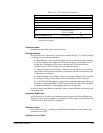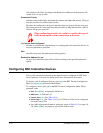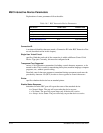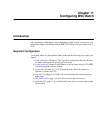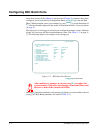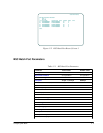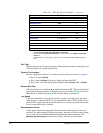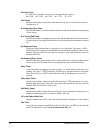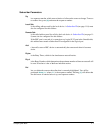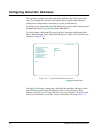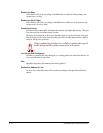
Configuring BSC Batch 11-5
The default value of
2000 ms
allows avoidance of unnecessary retransmission of
frames that have merely been delayed.
Maximum Retransmissions
is the maximum number of times the node will attempt to send an I-frame after a
Retransmission Period
expiration. A larger value for this parameter increases the prob-
ability of an eventual successful transmission, but a smaller value permits faster
detection of a permanent error condition.
Maximum Bytes per Frame
is the maximum frame size that will be transmitted on the port.
Generate Clock
specifies whether the port will generate the clock necessary to synchronize traffic over
the link. If the port is a physical DCE (determined by the port's I/O cable interface),
specify
Y
, since the physical DCE generates clock. If the port is DTE, specify
N
.
Rcv Clock (TT) from DTE
allows the clock to be looped back from the DTE using the TT (Terminal Timing)
signal, which can be helpful on high-speed lines. Generally, if the local interface is
physical DCE and the line speed is above 256 Kbps, this parameter should be set to
Y
.
(Make sure the remote DTE is configured to provide the terminal timing.)
EBCDIC
stands for "Extended Binary Coded Decimal Interchange Code." Specifying
Y
requires that all devices on a line use the same character set for successive session
polls. It is activated after a session is over; i.e., an EOT (End of Transmission) is suc-
cessfully transmitted down the line. On expiry, a
General Poll
is transmitted, except
under certain special conditions. The timer is deactivated at
Link Down
.
Transparent Text Supported
causes (if
Y
) all characters transmitted, including control character sequences, to be
treated as data. This is useful for transmitting binary data, machine language computer
programs, etc., without special coding.
Data-link control character sequences transmitted during transparent mode must be
preceded by character 1/0 (DLE) in order to be recognized as control characters.
Ack
specifies which methods of acknowledgement will be used:
A
= ETB:loc, ETX:end – local acknowledgement of transmission blocks,
end-to-end acknowledgement of text.
B
= ETB:end, ETX:end – end-to-end acknowledgement of transmission blocks
and text.
C
= ETB:loc, ETX:loc – local acknowledgement of transmission blocks and
text.
ETB = End of transmission block, ETX = End of text.



